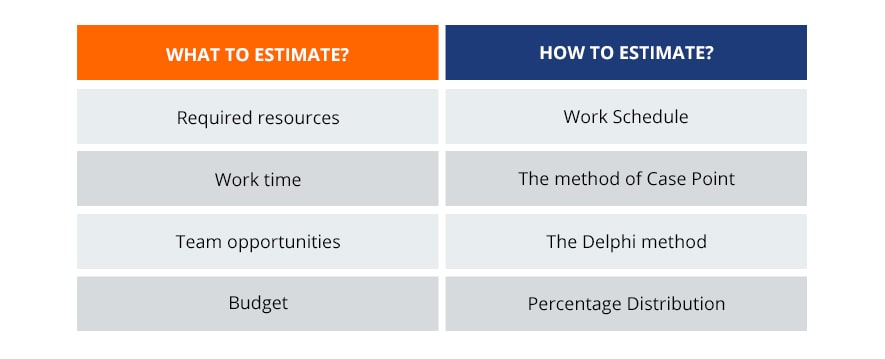- QATestLab Blog >
- QA Management >
- Test planning: How to hit the mark?
Planning, strategy, and management do not have a common lexical root. However, they all belong to one chain where the loss of one element might be a disruption for the whole case. QATestLab offers you a basic guide on creating and managing a Test Strategy with an effective formula on effort estimation so that you could follow the right path at the first try.
Basic elements of test planning strategy
Testing strategy is a guide that expresses the flow of testing in the software development cycle. It is created for use by PMs, testers, along with developers. Let’s see what it consists of:

- Scope and Tasks. This element defines the testing purpose and also defines and analyzes the possible risks at the project.
- Business industry standards to follow. The work performed should satisfy all the requirements of stakeholders without forgetting the business aspect.
- Roles and responsibilities. An important element of a testing strategy is the art of effectively distributing roles and responsibilities in a team.
- Status reporting. Regular reports are an important part of the strategy. They make work progress visible.
- Testing tools. The right choice of testing tools will make life easier for testers, and bring results faster, even at the stage of drafting a strategy.
- Issues tracking and reporting. Regular status reports are an important part of the strategy, like a partnership between a company and a client. It makes work progress visible but also a nice thing for avoiding disagreements and arguing on the project.
- Test results. This document is a part of the strategy. Still, this report is characterized as a conclusion on the process of testing.
You need to include all these elements into the plan to make it effective for the project. If you want to take the maximum value to all test plan elements, estimates will be the next step. They may be used even if the plan is at the stage of designing.
Effective formula on how to do effort estimate in QA testing plan
One of the methods for evaluating the labor costs for testing and checking fixes:
1. First, you need to fix the labor costs for the past project on:
- preparation of test cases;
- testing;
- fix check.
2. Then, you need to calculate the coefficients:
- k1 = time needed for testing/time for test cases
- k2 = time required to check for fixes/time for test scripts
- k3 = check of the fix time/test time
3. Estimate time for preparation of test scenarios.
4. We calculate the preliminary assessment following the assessment for the preparation of test scenarios.
Preliminary assessment for testing = assessment for the preparation of test scenarios × k1.
Preliminary assessment for fixing checks = evaluation for the preparation of test scenarios × k2.
When you finish writing the test scripts, your next step will be defining and adjusting the testing assessment.
Adjusted assessment for testing = assessment for the preparation of test scenarios × k1 refined assessment for fixing checks = evaluation for the preparation of test scenarios × k2
Now, when you have the formula on calculating the tech elements of the test plan, let’s focus on its management side. There are some techniques to control the test estimation, like for example, point estimates or work-phases. Nevertheless, they all have some similarities.

By answering “What?” and “How?” questions, you can improve the technical formula of testing estimates by yourself:
- Put in order the project into tasks.
- Give the task to the team members according to their opportunities and efforts that tasks need.
- Estimate these efforts.
- Make the validation of the estimates.
Estimates should be appropriate for test plan. It should be approved, including the result of all answers from the test plan discussions.
What questions to answer while designing a test plan
If you thought that it’s the end with questions than no, sorry. No one said it would be easy. But it can be if you answer these questions while designing your test plan:
- Do the testers know what the end-user needs?
There are a lot more nuances in developing a successful program. The importance of such a property of character as a caution (attention) in testers is on priority: it helps them to create a good test case. Testers feel the importance of full attention during the UAT (User Acceptance Testing). It’s a phase where the client is accepting the software. If the QA engineers don’t know about these demands initially, they will not be able to make cases that will give the answers. - How many work hours do testers have?
Complex development advance is a reason why QA engineer is so participating to make the right decisions for the project and its quality. When testers know estimates for testing at the very beginning of the project, they can effectively plan their time by correctly prioritizing. For example, methodological testing technique can be used to ensure that each new iteration is properly accomplished. - What are their tools?
For QA, there are many test management tools with clear dashboards and time trackers. This is required to keep everyone on one page.
Real conclusions and observations of QATestLab testers:
- Pessimistic assessment rarely exceeds optimistic more than 1.5 times.
- Regression testing, as a rule, takes 1/3 of the testing time. If testers spent 9 hours on basic testing, then 1/3 to 3 hours should be taken on regression testing. As a result, all testing (basic + regression) will take 12 hours.
- Depending on the complexity of the functionality, the time for 1 additional browser should be calculated at the rate of 1/2 or 1/3 of the time for the main browser.
- It is necessary to lay more time for testing if you need to compare pixel by pixel with layouts.
- In the assessment, it is also necessary to lay the time for writing a checklist, if the project is sufficiently functional.
- During the evaluation, it is important to lay the time for project management. It is usually added by the last paragraph and is 2-6 hours depending on the complexity and volume of the task.
- If localization testing is necessary, then it is optimal to offer the customer to check localization only in the main browser, on average it takes 3-4 hours, depending on the volume of the project.
When you got all the answers
Once all questions got their answers, testers will need to make extra intense to detailed daily movements. So, time to market, user requirements, and availability of project resources will carry on to drive management with quality over product release.
We at QATestLab wish you great projects with useful information from our blog. If you need more advice then check out our other articles.
Learn more from QATestLab
Related Posts:
- Test Strategies: Mix, Match and Succeed
- Issues to consider for preparation of test strategy
- What Aspects Must Testing Strategy Comprise?
About Article Author
view more articles








Awesome test planning strategy
Great you liked it!